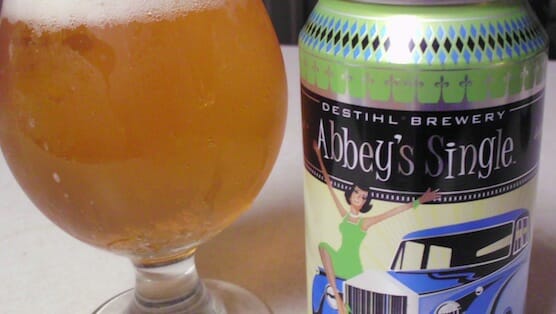
Belgian brewers have been creating what we would recognize as modern “craft beer” for hundreds of years, but despite a history that extends far further than American craft brewing, the styles are significantly less structured and organized. Only a few of the abbey styles are really well defined—brews such as dubbels, trippels and quads. I mean honestly, how much really separates most quadruples from Belgian dark strong ales? Likewise, a catch-all term like “Belgian pale ale” can mean a million different things. You pretty much have to judge all Belgian ales on a case-by-case basis, no matter what the style guidelines may say.
“Belgian single/singel” is one of those styles you don’t see very often in commercial brewing, to the point where a rating site like BeerAdvocate doesn’t even list it as its own style. Historically, these beers are the missing link of the abbey brewing tradition—you may have wondered why they started at “double” and moved upward? Singles were beers typically not designated for sale to the public, Belgian table beers/session ales that were consumed by the monks on a daily basis as a part of meals. They’re usually light in color and low in alcohol, a dietary supplement as much as anything, designed to be quaffed without getting the drinker intoxicated.
They’re also very refreshing brews, when done well. You might compare one to a session-strength saison with a fuller body, or an abbey dubbel stripped of its darker malt flavors and thinned out considerably. And in a market that is embracing session beer in a big way, they’re suddenly a more desirable/marketable option for lovers of Belgian beer who want to remain vertical throughout the course of an evening. The fact that St. Bernadus is now offering an abbey single as its “Extra 4” is evidence of this. As is this new beer from Central Illinois’ Destihl Brewery, Abbey’s Single.
Along with a DIPA, this beer was the first canned offering from Destihl, which has garnered national attention largely for its St. Dekkera sour series. It pours a slightly cloudy gold with a head of pillowy white foam, with aromas of hay, pepper and Juicy Fruit gum. There’s something in there like peach, along with some farmhouse ale funkiness.
On the palate this is light-bodied beer, but not without a nice malt presence. There’s pronounced breadiness/cracker-like malt, backed up by clove and characteristic Belgian funk. Carbonation is on the low side, which makes it feel slick, almost creamy. There are no hops to speak of, and it’s fairly dry, with just a touch of fruity sweetness—mixed berries, maybe.
It’s a brew that goes down very easily, which is exactly as intended. I really believe this is a style that is natural for session beer—packed with flavor, even at lower alcohol levels. Hopefully, more American brewers will take notice and start mass-producing low-alcohol, high-flavor Belgian ales.
Brewery: Destihl Brewery
City: Bloomington, IL
Style: Belgian abbey single
ABV: 4.9%
IBU: 22
Availability: Year-round, 12 oz. cans